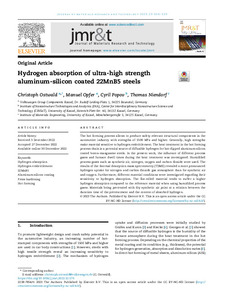Hydrogen absorption of ultra-high strength aluminum-silicon coated 22MnB5 steels
| dc.date.accessioned | 2023-07-24T10:26:10Z | |
| dc.date.available | 2023-07-24T10:26:10Z | |
| dc.date.issued | 2022-12-30 | |
| dc.identifier | doi:10.17170/kobra-202307198402 | |
| dc.identifier.uri | http://hdl.handle.net/123456789/14914 | |
| dc.language.iso | eng | |
| dc.rights | Attribution-NonCommercial-NoDerivatives 4.0 International | * |
| dc.rights.uri | http://creativecommons.org/licenses/by-nc-nd/4.0/ | * |
| dc.subject | hydrogen absorption | eng |
| dc.subject | hydrogen embrittlement | eng |
| dc.subject | 22MnB5 | eng |
| dc.subject | aluminum-silicon coating | eng |
| dc.subject | press hardening | eng |
| dc.subject | hot forming | eng |
| dc.subject.ddc | 660 | |
| dc.title | Hydrogen absorption of ultra-high strength aluminum-silicon coated 22MnB5 steels | eng |
| dc.type | Aufsatz | |
| dcterms.abstract | The hot forming process allows to produce safety-relevant structural components in the automotive industry with strengths of 1500 MPa and higher. Generally, high strengths make material sensitive to hydrogen embrittlement. The heat treatment in the hot forming process chain is a potential source of diffusible hydrogen for hot-dipped aluminum-silicon coated boron-manganese steels. In the present work, the influence of different process gases and furnace dwell times during the heat treatment was investigated. Humidified process gases such as synthetic air, nitrogen, oxygen and carbon dioxide were used. The results of the thermal desorption mass spectrometry (TDMS) revealed a more pronounced hydrogen uptake for nitrogen and carbon dioxide gas atmosphere than for synthetic air and oxygen. Furthermore, different material conditions were investigated regarding their sensitivity to hydrogen absorption. The flat-rolled material tends to suffer a higher hydrogen absorption compared to the reference material when using humidified process gases. Materials being pretreated with dry synthetic air point at a relation between the duration time of the pretreatment and the content of absorbed hydrogen. | eng |
| dcterms.accessRights | open access | |
| dcterms.creator | Ostwald, Christoph | |
| dcterms.creator | Opfer, Manuel | |
| dcterms.creator | Popov, Cyril | |
| dcterms.creator | Niendorf, Thomas | |
| dc.relation.doi | doi:10.1016/j.jmrt.2022.12.170 | |
| dc.subject.swd | Wasserstoffaufnahme | ger |
| dc.subject.swd | Wasserstoffversprödung | ger |
| dc.subject.swd | Mangan-Bor-Stahl | ger |
| dc.subject.swd | Beschichtung | ger |
| dc.subject.swd | Aluminiumlegierung | ger |
| dc.subject.swd | Siliciumlegierung | ger |
| dc.subject.swd | Formhärten | ger |
| dc.subject.swd | Warmumformen | ger |
| dc.type.version | publishedVersion | |
| dcterms.source.identifier | eissn:2214-0697 | |
| dcterms.source.journal | Journal of Materials Research and Technology | eng |
| dcterms.source.pageinfo | 106-113 | |
| dcterms.source.volume | Volume 23 | |
| kup.iskup | false |
Dateien zu dieser Ressource
Das Dokument erscheint in:
-
Publikationen [82]


